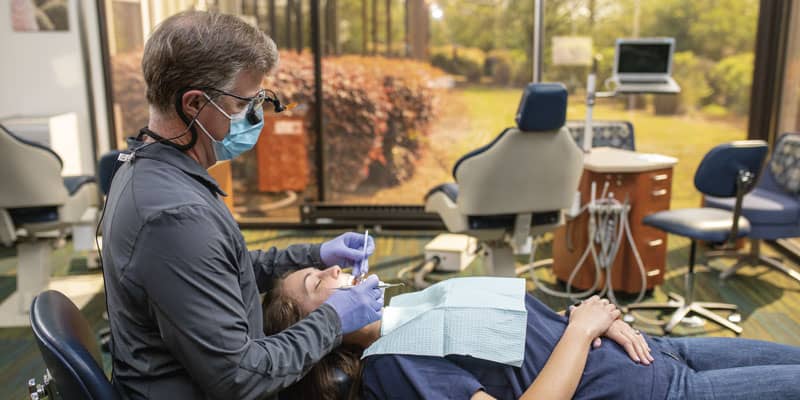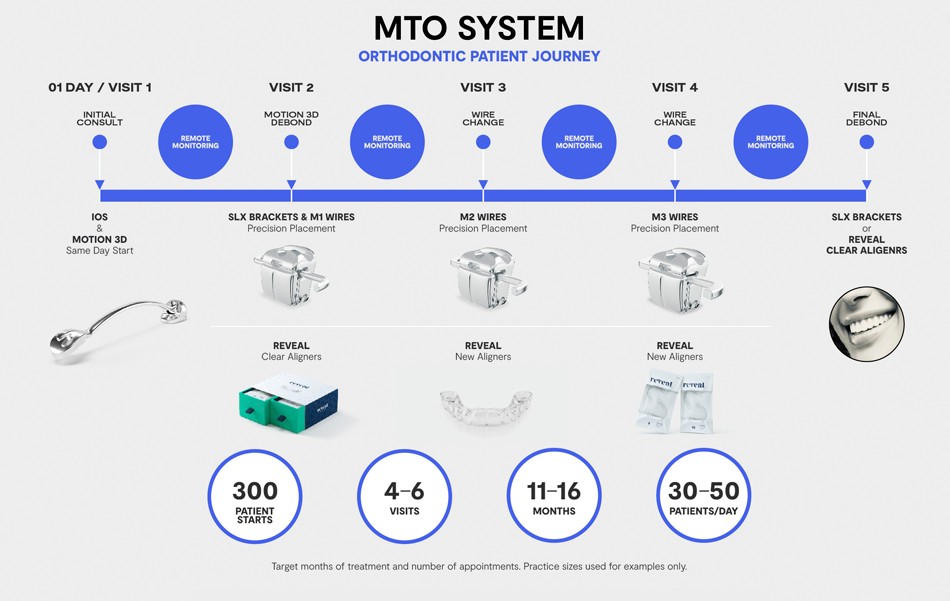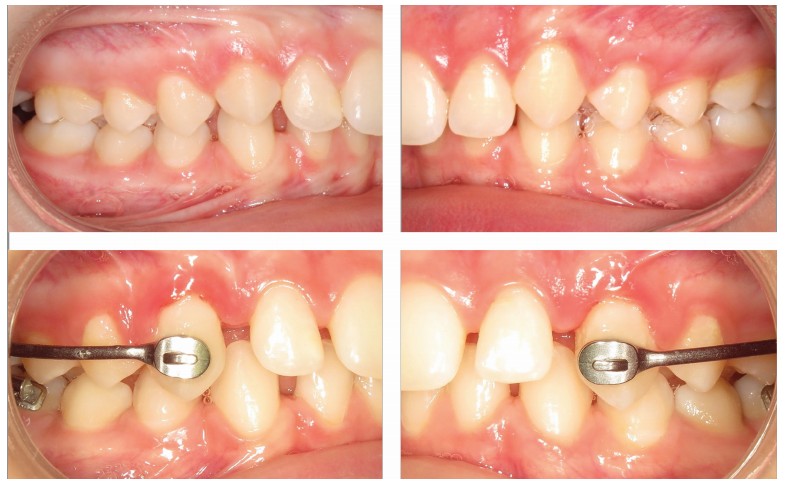Dr. Jep Paschal shows how Minimum Touch Orthodontics (MTO) maximizes virtual appointments for superior patient convenience and enhanced patient experiences.

Dr. Jep Paschal reimagined his practice workflow to achieve an enhanced patient experience
Minimum Touch OrthodonticsSM (MTO) is an orthodontic workflow philosophy Henry Schein® Orthodontics™ (HSO) launched, under the guidance of its clinical advisory orthodontists, to assist ortho-dontists in focusing their efforts during the pandemic toward one goal — to deliver simplified, predictable results in fewer and shorter appointments with reduced treatment times, while maximizing virtual appointments for superior patient convenience and enhanced patient experiences.
For Dr. Jep Paschal, the true value of MTO evolved over time. Already using innovative appliances and efficient mechanics, he had thought of MTO primarily in terms of minimizing treatment time. When he and his team reevaluated their workflow according to patient needs during COVID-19, they began to embrace the MTO concept of convenience more holistically. How often could they substitute virtual appointments for physical appointments? What multiple technologies would allow them to do that simply and effectively? How could they make each physical appointment shorter and less invasive? What about scheduling? Same-day starts?
Using MTO as the model, patient communications have changed dramatically in the Paschal practice over the last year. Virtual consults have become an option with significant reliance on texting, email exchanges, and Google Meet, plus targeted use of remote monitoring solutions such as Dental Monitoring™ (DM) and Grin, which offers a convenient and cost-effective platform that enables superior patient care while supplying orthodontists the tools to scale their practice.“We hand out disposable cheek retractors like candy,” Dr. Paschal teases, “because we encourage patients to approach us virtually if they prefer. This has been a huge cultural shift for our practice, but one that has been extremely well received by patients and parents.”

Same-day starts made practical
Same-day starts (SDS) are fundamental to patient convenience and MTO. The SAGITTAL FIRST™ concept, fueled by the Carriere® Motion 3D™ Appliance for A/P correction, makes same-day starts practical. Using the Motion 3D Appliance to establish a CL I platform prior to completing treatment in aligners or braces simplifies finishing and can considerably reduce overall treatment time.
From their first patient interactions, the Paschal team communicates that patients can start same day. “Not only are SDSs good for profitability, they’re what people want now given that online options such as Smile Direct Club™ and Candid™ are available,” Dr. Paschal explains. “Motion 3D has been essential to getting our SDS numbers from 55% to 75% because Motion takes only 15 minutes to bond (4 minutes for me) and fits easily into the schedule.” With fast in-house printers, the Paschal team can deliver the opposite-arch aligner on the same day. Using Motion 3D to satisfy MTO also minimizes the number of treatment-planning decisions. With the Motion 3D Appliance, there is no protocol change for different malocclusion types. “I don’t need to determine how I’m going to resolve the A/P for each patient,” Dr. Paschal adds. “If there’s an A/P issue, we utilize Motion 3D.”
It was Dr. Luis Carrière, the Motion 3D Appliance inventor, who introduced Dr. Paschal properly to Motion 3D. “My practice was transformed that day,” Dr. Paschal said. ”I was looking at Luis’s cases, his results, and timelines. I wasn’t getting those results, and I wasn’t getting remotely close to his timelines. We were using Carriere SLX® 3D brackets and the same archwires. The only variable was the Motion 3D Appliance.”
Appliances that support MTO
For many years, Herbst had been the A/P treatment appliance of choice for most clinicians if simple elastics weren’t suitable or surgery wasn’t indicated. “Motion 3D fostered a paradigm shift in my practice,” Dr. Paschal affirms. “We went from 12 months for Herbst correction to 4 to 6 months with Motion 3D, cutting A/P treatment time in half (Figure 1). We’re now seeing 14 to 16 months for average overall treatment times with either braces or aligners, even with a full-step CL II.” Having to make the aligners-versus-braces choice during the consult had always been a sticking point. Motion 3D has removed this barrier because patients don’t need to make this decision until the end of Motion treatment.

The Motion 3D Appliance standardizes workflow, making it predictable. CL II — even full-step CL II — CL III and unilateral cases can be accommodated. The appliance also lends itself to remote monitoring, further reducing physical appointments.
Miranda Bacon, Treatment Coordinator for Paschal Orthodontics and former Clinical Assistant, continues, “Motion 3D takes only 4 minutes of doctor time to bond, so it’s definitely minimum touch, and we can use it for both adults and kids, even kids in mixed dentition. We tell patients, ‘If you wear it, it works.’ It’s gas to a Porsche; the charger to an iPhone. It does require patient compliance, but adults have just invested in treatment, so they’re highly motivated, and you might be surprised, but kids are so ready to get their braces or aligners, they usually wear their elastics as they should.” Since SAGITTAL FIRST dictates that Motion 3D be used prior to brackets or aligners, it’s simple for patients to see progress, which helps keep them engaged and fosters compliance.
“Transitioning to Motion 3D removed the only true emergency in our practice,” Dr. Paschal explains. If Motion debonds, there is no must-see visit. The patient is simply told to remove it, stop wearing elastics, and schedule the 10-minute rebond. “I love it when we’re the second opinion, and Miranda shows the Motion 3D Appliance versus Herbst,” Dr. Paschal smiles. “When prospective patients see the difference, they sigh in relief. ‘Everyone at my lunch table has one,’ they tell us. Motion 3D starts up to 70% of our patients these days. When I think how far we’ve come in only a few years, I marvel at the improvements.”
In terms of same-day starts for CL I patients who don’t require Motion 3D, the Paschal team takes facial photos and a scan at the start of every consult, so can move forward quickly, whether the patient wants aligners or braces. Dr. Paschal has reduced the fee schedules for full dentition cases to two, so that Ms. Bacon can confidently quote fees regardless of the complexity of the case.
Clear aligners and virtual monitoring
After CL I is achieved, patients can complete treatment in Reveal® Clear Aligners, other aligners, or fixed appliances. HSO’s Reveal Clear Aligners are a cost-effective treatment solution, designed to treat mild to complex malocclusions. They are recognized for advanced clarity, comfort, and superior tooth adaptation, especially interproximally, reducing the need for unsightly attachments.
Aligner cases offer an excellent opportunity for remote monitoring and MTO. Dr. Paschal follows aligner cases using Dental Monitoring (DM) and brands all remote monitoring as Paschal Remote. For one patient, Paschal Remote can be a smartphone and cheek retractors. For another, it can mean Dental Monitoring. To his patient, it’s all Paschal Remote. Dr. Paschal finds that virtual monitoring more closely ties the patient to the practice than he would have anticipated. “You would think that remote monitoring would make the patient less involved with the practice because there are fewer physical contacts,” Dr. Paschal acknowledges, “but we’re finding that patients actually have more interaction with our office through virtual monitoring because the DM app reaches out to them weekly to take action.”
Ms. Bacon adds, “If the patient had a bad week or was on vacation, for example, and didn’t wear the aligners as required, remote monitoring can prompt us to extend aligner wear for a few days. For in-house aligner cases, it takes the guesswork out of when to schedule the patient for the new set. DM lets us track progress, and we work ahead, so we don’t lose time with the patient being in aligners that are only acting as retainers at that point.”
A straightforward wire sequence
If the choice to complete treatment is fixed appliances, HSO offers the Carriere SLX 3D Self-Ligating Bracket System, which now includes PSL first molar tubes (Figure 2). Dr. Paschal feels SLX 3D Brackets greatly expand his scope of care, specifically in minimizing extractions. SLX 3D Brackets feature the Carriere M-Series™ Wires, a 3-wire sequence, that make it a complete system with standardized protocols. The critical pain point for most orthodontists is wire sequence. M-Series is straightforward: M1, M2, M3. There are additional wires for expansion, severe rotations, etc., and the newly introduced overexpressed wires for crossbites. This three-wire series translates to a predictable workflow, easier team communication, ordering and inventory control.

The cornerstone of the three-wire sequence is the M2 (0.020” x 0.020”) archwire. “With the self-ligation system I used previously,” Dr. Paschal explains, “the door was not wide enough to take advantage of this size wire. With Motion 3D stimulating interstitial fibers, cases can move into the M1 wire, a larger dimension starting wire (0.015”) than is typical for PSL, then the team can insert the M2 wire even with brackets slightly out of alignment far earlier in treatment for easier and faster finishing. Because the mesial-distal dimension of the SLX 3D bracket is designed to accommodate this square wire, it fully engages it. M3, the final adjustable wire, then finishes treatment. We treat more than 60% of our cases with this three-wire sequence to excellent results. No guesswork. Minimum Touch.”
MTO beyond this time
Convenience and personal experience have long been the driving forces behind consumers’ purchasing decisions. The pandemic made it more so. Using MTO as a lens through which to reimagine practice workflow can satisfy patients’ even greater need for convenience. That and patients’ new openness to digital communications can offer opportunities that should serve practices well beyond this time.
A part of Dr. Pascal’s Minimum Touch Orthodontics (MTO) philosophy is same day starts, which uses the SAGGITAL FIRST philosophy. Read more about it here: https://orthopracticeus.com/henry-schein-orthodontics-3/
Stay Relevant With Orthodontic Practice US
Join our email list for CE courses and webinars, articles and mores


